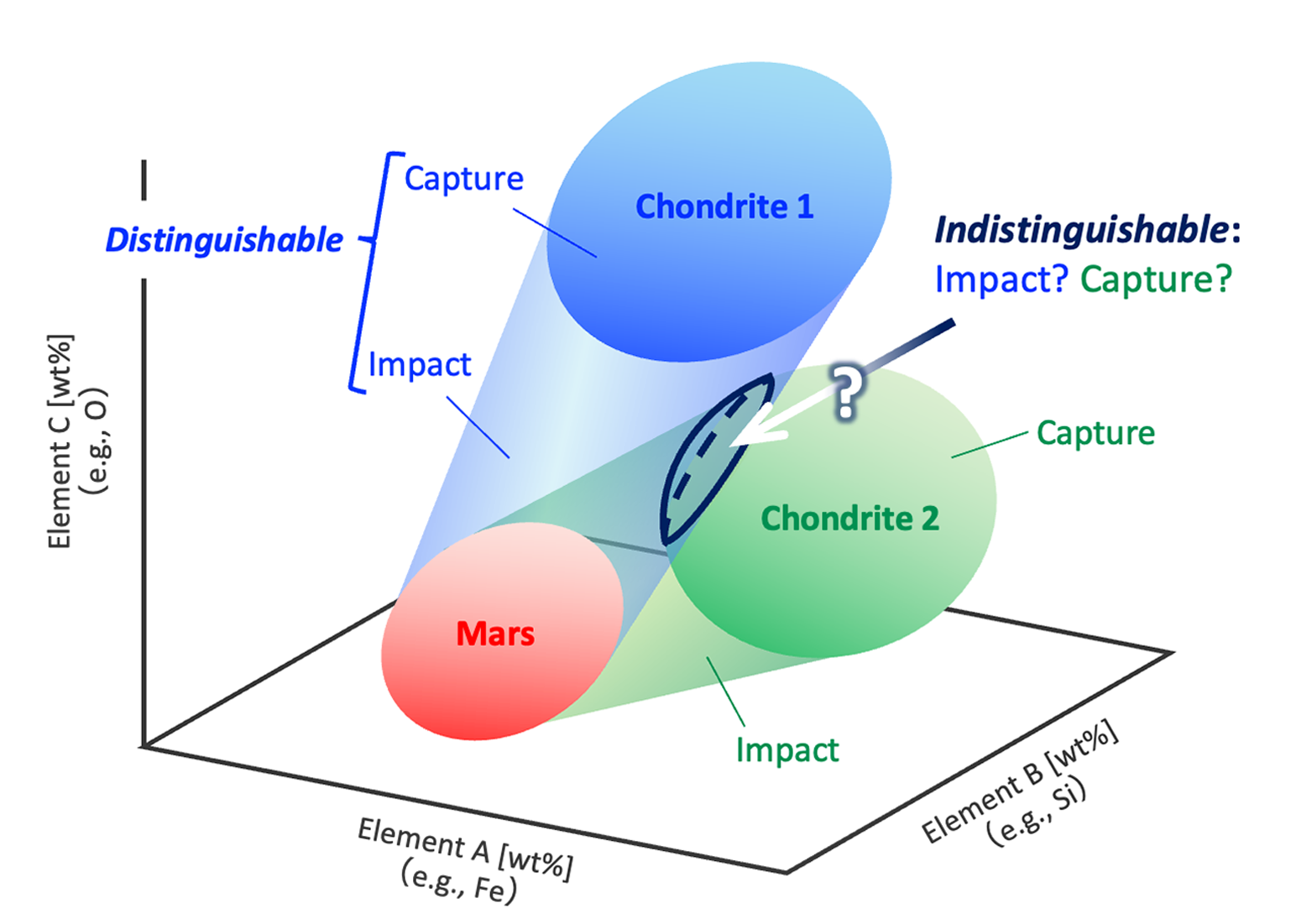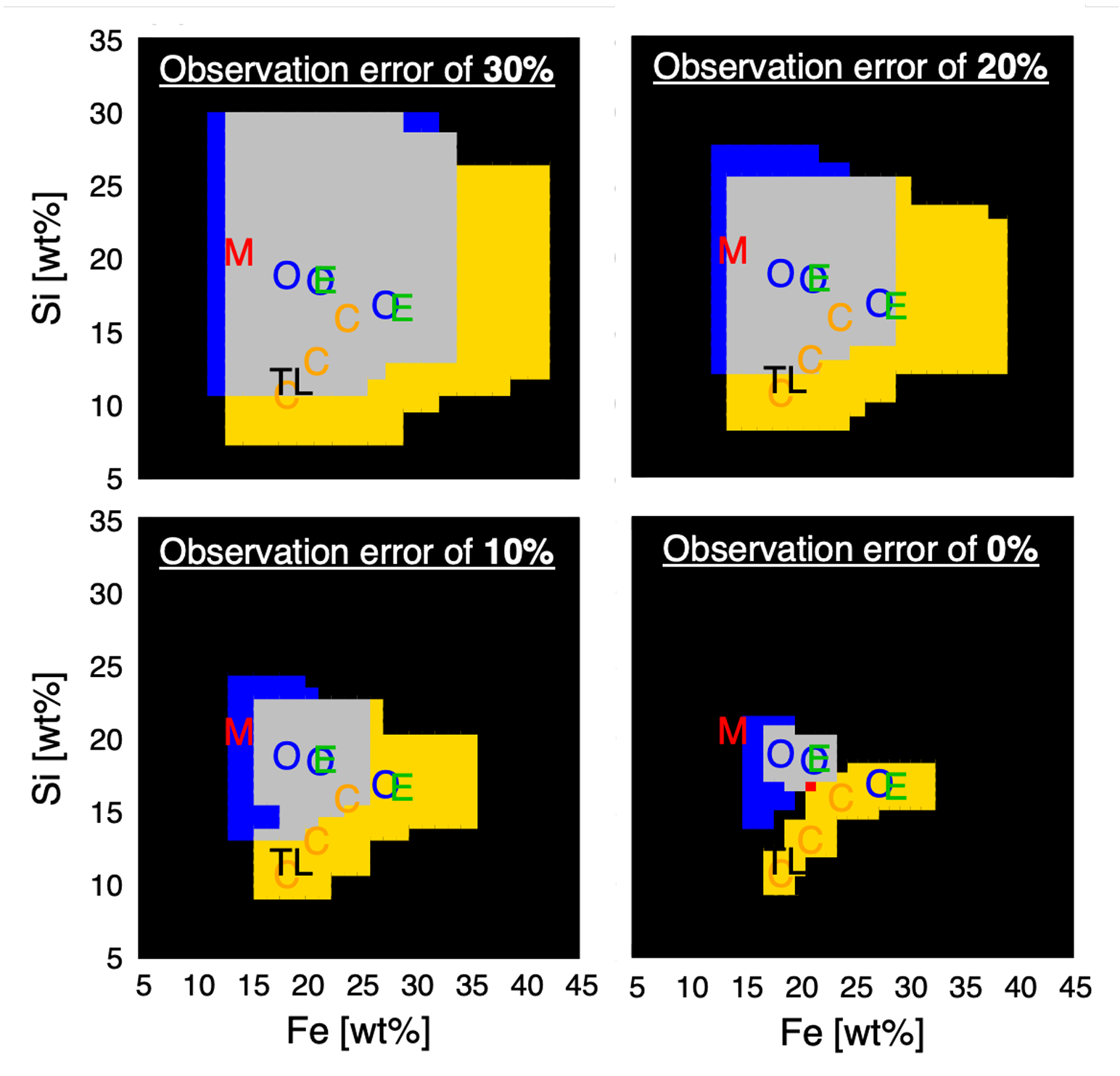Formation process of the Martian moons that can be revealed from the elemental composition observations: Evaluation of MMX MEGANE’s performance using Phobos’ elemental composition model
Jun. 11, 2024 | GATEWAY to Academic Articles
“How were the two Martian moons, Phobos and Deimos, formed?” There are two leading hypotheses: the asteroid-capture origin, which is suggested by their surface color and texture, and the giant-impact origin, which reasonably explains their orbital properties. JAXA’s Martian Moons eXploration (MMX) mission aims to answer the question by comprehensive scientific observations and detailed ground analysis of samples returned from the surface of Phobos.
This study focuses on examinations of the elemental composition of Phobos to distinguish different formation processes. Phobos’ elemental composition is modeled assuming each of the two formation hypotheses to examine to what extent the resultant Phobos compositions are similar to or distinct from each other.
Using this model, this study reported that the formation hypothesis of Phobos can be discriminated based on the observations that will be captured by the MEGANE instrument onboard MMX, which will measure the surface elemental composition of Phobos, with a performance of ~70%. Furthermore, MEGANE observations might potentially determine the asteroid type of a captured body or an impactor. MEGANE observations, along with other science observations, are expected to make a significant contribution to achieving the science goal of MMX.
Research Summary
The two Martian moons, Phobos and Deimos, have been studied by observations from spacecrafts and with ground-based telescopes. However, the origin of the Martian moons still remains controversial with two leading hypotheses: the asteroid-capture origin, where an asteroid was gravitationally captured when it passed near Mars, and the giant-impact origin, where the Martian moons were formed from the accumulation of debris in a circum-Martian disk formed by a giant impact with Mars (Fig. 1). Elemental composition is the key to distinguishing these two origins. In the case of the asteroid-capture hypothesis, the composition of the Martian moons should correspond to the captured asteroid, while an impact-origin is thought to lead to an intermediate mix between that of Mars (BSM: Bulk Silicate Mars composition*1) and that of the impactor (Fig. 1). JAXA’s Martian Moons eXploration (MMX) aims to reveal the origin of Martian moons and plans to measure the average elemental composition of the upper 1 meter of the surface of Phobos using the gamma-ray neutron spectrometer MEGANE*2, which has been developed at the Johns Hopkins Applied Physics Laboratory on behalf of NASA. This study aims to discriminate the formation hypotheses based on the elemental composition of Phobos observed by MEGANE in the future, considering the realistic constraints such as the observation error of MEGANE and the uncertainty of type and composition of a captured/impacted body.

We constructed a mixing model that represented the elemental composition of Phobos from a mixing of Martian and asteroidal compositions: 0% Martian component +100% asteroidal component for the capture origin, and 50% Martian component +50% asteroidal component for the impact origin (Fig. 2). Assuming the two formation hypotheses and compositions of 12 chondrite meteorites*3 for asteroidal components, 24 cases of different formation processes and the resultant elemental compositions of Phobos were modeled. Using 6 lithophile elements*4 measurable by MEGANE (Fe, Si, O, Ca, Mg, and Th), we investigated to what extent the compositions overlapped or differed from each other.

This study quantitatively showed that the distinguishability between the formation hypotheses from the compositional observations by MEGANE depended on its observation error (Fig. 3). Assuming the errors from the initial instrument requirement (20-30%), the ability to distinguish the formation origins was calculated to be ~70%. Furthermore, when the formation origin is determined uniquely, the type of captured/impacted asteroid could also be determined uniquely from among 12 types with a probability of about 50%.

Our elemental composition model and the data analysis can be applied to the MEGANE observation data acquired by MMX in the future. For further advancements, the types of asteroidal compositions could be added or based on other scientific observations by MMX, progressing towards a better understanding of the formation process. The elemental composition observations of Phobos by MEGANE, together with other science observations by MMX, are expected to contribute greatly to the understanding of the origin of the Martian moons.
Terminologies
- *1 Bulk Silicate Mars composition: The average composition of the silicate portion, i.e., the crust and mantle composed of rocks, of Mars. The giant impact origin of the Martian moons predicts that the crust and mantle materials of Mars are ejected to the space by the impact event and compose a part of the Martian moons .
- *2 MEGANE: Mars-moon Exploration with GAmma rays and Neutrons, the gamma-ray and neutron spectrometer onboard the MMX spacecraft. MEGANE will measure the elemental composition by detecting gamma-rays or neutrons generated by atoms constituting surface materials when galactic cosmic rays are incident.
- *3 Chondrite: Stony meteorites, which are composed mainly of silicate minerals rather than metals, that contains a granular texture called chondrules inside. Chondrules are thought to have been formed by the rapid cooling of silicate minerals molten like magma and are preserved without re-melting. Thus, parent bodies of chondrites are considered to be primitive bodies that have not experienced differentiation in high temperatures.
- *4 Lithophile elements: Elements that tend to be concentrated in the silicate phase during differentiation a homogeneous melting state. For example, Na, Mg, Al, Si, etc. Incidentally, Siderophile elements include those tend to concentrate in the metallic phase along with iron and Atmophile elements include those tend to become gaseous.
Information
| Journal Title | Icarus |
|---|---|
| Full title of the paper | Mixing model of Phobos’ bulk elemental composition for the determination of its origin: Multivariate analysis of MMX/MEGANE data |
| DOI | https://doi.org/10.1016/j.icarus.2023.115891 |
| Publish date | 24 November 2023 (Available online), 1 March 2024 (Issue published) |
| Author(s) | Kaori Hirata, Tomohiro Usui, Ryuki Hyodo, Hidenori Genda, Ryota Fukai, David J. Lawrence, Nancy L. Chabot, Patrick N. Peplowski, Hiroki Kusano |
| ISAS or JAXA member(s) among author(s) | HIRATA Kaori (Dept. of Solar System Science, ISAS), USUI Tomohiro (Dept. of Solar System Science, ISAS), HYODO Ryuki (Dept. of Solar System Science, ISAS), FUKAI Ryota (Dept. of Solar System Science, ISAS) |


 HIRATA Kaori / Dept. of Solar System Science, ISAS,
HIRATA Kaori / Dept. of Solar System Science, ISAS,